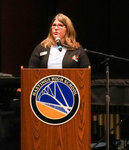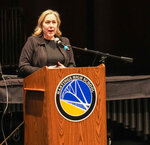The City of Hastings put everything on the table Thursday night, building its case that it deserves funding help to fight its battle against PFAS and PFOS forever chemical contaminants in its …
This item is available in full to subscribers.
To continue reading, you will need to either log in, using the login form, below, or purchase a new subscription.
If you are a current print subscriber, you can set up a free website account and connect your subscription to it by clicking here.
Otherwise, click here to view your options for subscribing.
Please log in to continue |



The City of Hastings put everything on the table Thursday night, building its case that it deserves funding help to fight its battle against PFAS and PFOS forever chemical contaminants in its drinking water.
City staff was joined by experts from the Minnesota Department of Health and the Minnesota Pollution Control Agency at the meeting attended by hundreds of people in the Hastings High School Auditorium.
New federal standards announced last month mean that Hastings drinking water supply has PFAS or PFOS contamination in them that exceeds the newly enacted Environmental Protection Agency requirements that the water supply can’t have in excess of four parts per trillion of the contaminants. According to the EPA the standard reduces exposure from PFAS and PFOS to “the lowest levels that are feasible for effective implementation.”
A Minnesota Health Department representative at the meeting – Lucas Martin – said that level is the equivalent of “one drop of water in 20 Olympic-sized swimming pools.”
Hastings is in a precarious situation, as it needs to come up with upwards of $70 million to have three water treatment plants operational in the next five years. MPCA mandates that municipalities over the EPA standard have the problem fixed within that time frame.
Hastings plans to be ready to go with its first treatment plant this fall. It has turned to the Minnesota Legislature, Gov. Tim Walz and grant programs for at least $20 million to get its first project underway. That would treat two city wells and the water at the Hastings Veterans Home, which is also contaminated with PFAS.
Hastings has been alerting the public for a couple years about the problem. On the funding side, the MPCA is still testing city wells and has drilled other monitoring wells to find the source of the contamination. Fingers for part of the problem are obviously being pointed to the 3M facility just north of Hastings in Cottage Grove. 3M plant discharge of PFAS chemicals is blamed for contamination in many East Metro communities, and a fund exists from an $850 million settlement with the manufacturer.
Experts say there are fault lines under the Mississippi River, but they won’t conclusively say that 3M is to blame. But if their research leads to that conclusion, Hastings will have access to settlement funds.
“I and the council have made it our number one priority for safe drinking water in the City of Hastings. Staff has been working diligently for a solution. Hastings’ entire water system is compromised, with no other feasible option except treatment to serve 23,000 people,” Mayor Mary Fasbender said in starting off the three-hour meeting. “No individual should have to drink water that is below the federal law. We’ve worked very hard and have done everything we can to this point. We are seeking financial help.”
District 41B State Sen. Judy Seeberger, of Afton, was blunter.
“I was fortunate enough to be in a town that was part of the 3M settlement funds, and I know that Hastings has been excluded which is not OK with me. At the state level, I’m doing everything I can to get the funding necessary for the water treatment plants that Hastings is ready to build,” she said. “The issue right now is money that shouldn’t be borne on the backs of the citizens of Hastings. I believe the state should step in and pay money. I believe the MPCA should use some of the money within the settlement funds to pay for this. This is what I’m fighting for.”
She called out MPCA Assistant Commissioner Kirk Koudelka, who was present at the Hastings meeting also.
“We had a meeting, and I was very dissatisfied with his responses. I believe that he can do more and should do more to provide the funding to Hastings to pay for the water treatment. There is no reason why Hastings should be carved out of those settlement funds, absolutely no reason. I am fighting for you. I’m doing everything I can,” said Seeberger.
Kristine Klos took the floor and explained what PFAS are - per and polyfluorinated chemicals.
“There are thousands of them,” she said. They were introduced in the 1940s by 3M and DuPont.
“We’ve been exposed our whole lives to PFAS. They were used in so many products, and that’s why they’re everywhere, and 98 % of us have these in our blood.”
Martin, a Dept. of Health engineer, talked about filtering out the chemicals and how the water treatment systems work.
He talked about how residents can reduce exposure and directed people to the Department of Health website (Google “MDH PFAS treatment) where there is information on home filtration systems, such as granular activated carbon filters that attach to the faucet.
“We’ve actually tested some of these ourselves. They work really well,” Martin said. He said there are also reverse osmosis systems that attach under the sink.
Koudelka and Andri Dahlmeier from the MPCA said the agency is working to try to find PFAS sources in Hastings. It could be 3M, but there are a couple other spots being monitored. There’s the former Pine Street dump, as well as the site of Oak Ridge Manor Apartments where there was a large fire in the late 1980s that may have been fought with firefighting chemicials containing PFAS. There are also other manufacturing sites where PFAS could have been discharged.
Koudelka said making the link is important because then there’s a responsible party that has to pay for cleanup.
Dahlmeier said all told, there are 54 different sites that are potential sources of PFAS contamination in the Hastings drinking water area.
“There could be multiple sources that are impacting Hastings wells,” she said. “We’re drilling at several sites now.”
She said that one Hastings well is contaminated with a chemical compound unique to 3M Cottage Grove.
“And that also is on one of those fault lines, so we think there could be a connection there,” said Dahlmeier.
During the question and answer period, one resident asked why it took so longer for the city to notify residents about the water problem if they knew in 2022. City administrator Dan Wietecha said the city has held multiple public meetings on PFAS and sent out many notifications to the public.
Another resident asked if the city would pay for home filtration systems. City Public Works Director/Engineer Ryan Stempski said that for the city to do that, they’d have to raise water rates.
One resident asked: “How worried should we be.”
“I think it’s a good question, but I think that’s above any knowledge that we know. I just don’t even know how to answer that,” said Klos.
Martin said the Department of Health has resources on its website.
Another person asked why no one from Dakota County government was at the meeting. “Where’s their commitment to this?” he asked.
A woman asked what the city’s plan is for the next five years for providing safe water.
“You are my only source of water,” she said. “I want to put it on the city of Hastings to create a plan for the City of Hastings for the next five years so we can protect ourselves.”
She suggested partnering with vendors for filter systems.
“Everyone in this room is very concerned about these five years,” she said.
Stempski said the city is in a tough position because it can’t fund a short-term plan.
“We don’t have the funding,” he said. “That’s what’s frustrating for me. We talked about the 3M Settlement Fund we’re trying to get into. I’ve worked in other communities in this situation and bottled water has been provided for those communities. I don’t have that situation. I have no resource to provide the residents other than increasing water rates to do something like that.”
The questioner responded, “We tried to promote Hastings and our business district, and those businesses are using the water, our restaurants, our coffee shops or other businesses. It affects the growth of our city. It affects the ability for us to maintain the value of our homes and sell our homes if people want to move to Hastings and realize the water is unsafe to drink.”